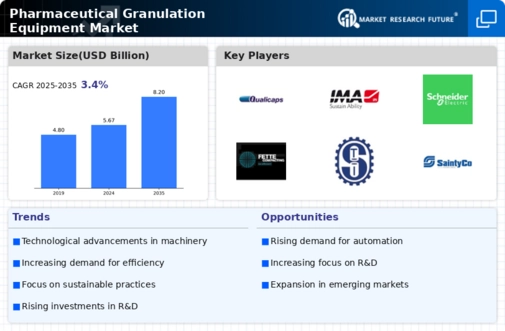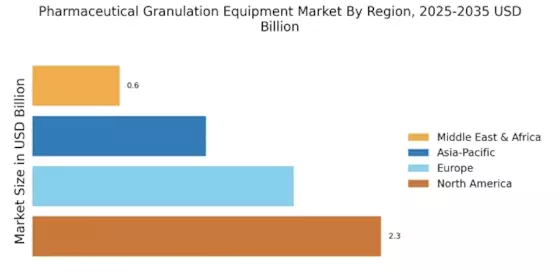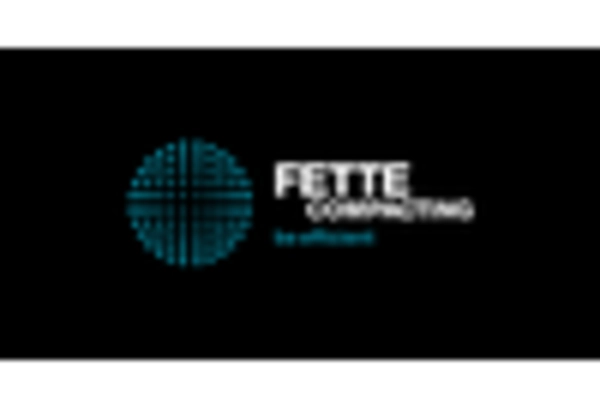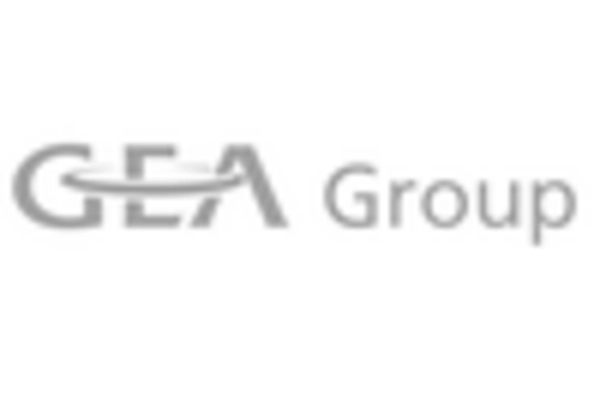Increasing Investment in Pharmaceutical R&D
Investment in pharmaceutical research and development is a critical driver for the Pharmaceutical Granulation Equipment Market. As companies allocate more resources to R&D, the demand for high-quality granulation equipment rises. This investment is often aimed at developing new drugs and improving existing formulations, which in turn requires advanced granulation technologies. Recent data suggests that global pharmaceutical R&D spending has reached over 200 billion USD annually, reflecting a robust commitment to innovation. Consequently, the need for efficient and reliable granulation equipment is likely to increase, as manufacturers seek to optimize production processes and ensure compliance with stringent quality standards.
Regulatory Compliance and Quality Assurance
Regulatory compliance and quality assurance are paramount in the Pharmaceutical Granulation Equipment Market. As regulatory bodies impose stricter guidelines on drug manufacturing processes, the demand for equipment that meets these standards is increasing. Pharmaceutical companies are compelled to invest in advanced granulation technologies that ensure consistent product quality and compliance with Good Manufacturing Practices (GMP). Data suggests that the global market for pharmaceutical quality assurance is expected to grow significantly, further driving the need for reliable granulation equipment. This trend underscores the importance of integrating quality control measures into the granulation process, thereby enhancing the overall efficiency and safety of pharmaceutical production.
Rising Demand for Advanced Drug Formulations
The Pharmaceutical Granulation Equipment Market is experiencing a notable increase in demand for advanced drug formulations. This trend is driven by the need for more effective and targeted therapies, which require sophisticated granulation processes. As pharmaceutical companies strive to enhance bioavailability and stability of drugs, the adoption of advanced granulation technologies becomes essential. Market data indicates that the granulation equipment segment is projected to grow at a compound annual growth rate of approximately 6.5% over the next five years. This growth is indicative of the industry's shift towards more complex formulations, necessitating the use of specialized granulation equipment to meet evolving regulatory standards and patient needs.
Growing Focus on Patient-Centric Drug Delivery Systems
The Pharmaceutical Granulation Equipment Market is increasingly influenced by the growing focus on patient-centric drug delivery systems. This approach emphasizes the development of formulations that enhance patient adherence and therapeutic outcomes. As a result, pharmaceutical companies are investing in granulation technologies that allow for the creation of customized drug forms, such as controlled-release and combination therapies. Market analysis indicates that the demand for such patient-centric solutions is expected to drive the granulation equipment market, with a projected growth rate of around 5% in the coming years. This shift towards personalized medicine necessitates advanced granulation processes to ensure the efficacy and safety of new drug formulations.
Emergence of Contract Manufacturing Organizations (CMOs)
The rise of Contract Manufacturing Organizations (CMOs) is a significant driver for the Pharmaceutical Granulation Equipment Market. As pharmaceutical companies increasingly outsource their manufacturing processes to CMOs, the demand for advanced granulation equipment is likely to surge. CMOs require state-of-the-art technologies to meet the diverse needs of their clients, including the production of complex formulations and compliance with regulatory standards. Recent Market Research Future indicate that the CMO sector is expanding rapidly, with a projected growth rate of over 7% in the next few years. This trend suggests that the granulation equipment market will benefit from the increasing reliance on CMOs, as they seek to enhance their production capabilities and efficiency.


















Leave a Comment